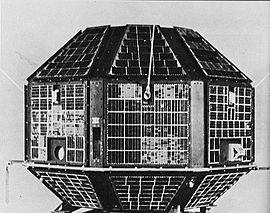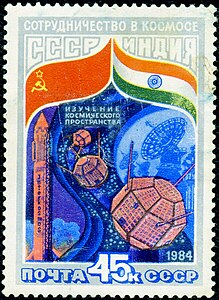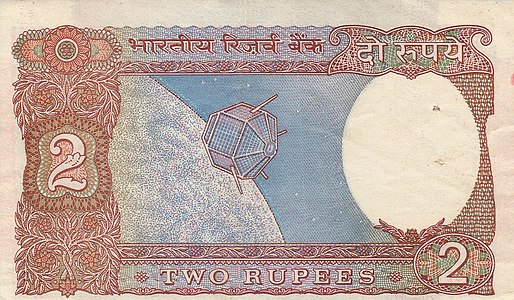Kosmos 53, also known as DS-A1 No.5 was a technology demonstration satellite which was launched by the Soviet Union in 1965 as part of the Dnepropetrovsk Sputnik programme. Its primary mission was to demonstrate technologies for future Soviet military satellites. It also conducted radiation experiments.
Kosmos 25, also known as DS-P1 No.4 was a prototype radar target satellite for anti-ballistic missile tests, which was launched by the Soviet Union in 1964 as part of the Dnepropetrovsk Sputnik programme. Its primary mission was to demonstrate the necessary technologies for radar tracking of spacecraft, which would allow future satellites to function as targets.
Kosmos 36, also known as DS-P1-Yu #1 was a satellite which was used for use in calibrating the Dnestr space surveillance and as a radar calibration target, for tests of anti-ballistic missiles. It was launched by the Soviet Union in 1964 as part of the Dnepropetrovsk Sputnik programme. It was built by the Yuzhnoye Design Bureau.
Kosmos 76, also known as DS-P1-Yu No.3 was a Soviet satellite which was used as a radar calibration target for tests of anti-ballistic missiles. It was built by the Yuzhnoye Design Bureau, and launched in 1965 as part of the Dnepropetrovsk Sputnik programme.
Kosmos 101, also known as DS-P1-Yu No.4 was a Soviet satellite which was used as a radar calibration target for tests of anti-ballistic missiles. It was built by the Yuzhnoye Design Bureau, and launched in 1965 as part of the Dnepropetrovsk Sputnik programme.
Kosmos 123, also known as DS-P1-Yu No.5 was a Soviet satellite which was used as a radar calibration target for tests of anti-ballistic missiles. It was built by the Yuzhnoye Design Bureau, and launched in 1966 as part of the Dnepropetrovsk Sputnik programme.
Kosmos 268, known before launch as DS-P1-Yu No.18, was a Soviet satellite which was used as a radar calibration target for tests of anti-ballistic missiles. It was a 250-kilogram (550 lb) spacecraft, which was built by the Yuzhnoye Design Bureau, and launched in 1969 as part of the Dnepropetrovsk Sputnik programme.
Kosmos 307, known before launch as DS-P1-Yu No.22, was a Soviet satellite launched in 1969 as part of the Dnepropetrovsk Sputnik programme. It was a 250-kilogram (550 lb) spacecraft, which was built by the Yuzhnoye Design Bureau, and was used as a radar calibration target for anti-ballistic missile tests.
Kosmos 347, known before launch as DS-P1-Yu No.35, was a Soviet satellite which was launched in 1970 as part of the Dnepropetrovsk Sputnik programme. It was a 250-kilogram (550 lb) spacecraft, which was built by the Yuzhnoye Design Bureau, and was used as a radar calibration target for anti-ballistic missile tests.
Kosmos 501, known before launch as DS-P1-Yu No.50, was a Soviet satellite which was launched in 1972 as part of the Dnepropetrovsk Sputnik programme. It was a 250-kilogram (550 lb) spacecraft, which was built by the Yuzhnoye Design Bureau, and was used as a radar calibration target for anti-ballistic missile tests.
Kosmos 108, also known as DS-U1-G No.1, was a Soviet satellite which was launched in 1966 as part of the Dnepropetrovsk Sputnik programme. It was a 355 kilograms (783 lb) spacecraft, which was built by the Yuzhnoye Design Office and was used to study the effects of solar activity on the upper atmosphere.
Kosmos 93, also known as DS-U2-V No.1, was a Soviet satellite which was launched in 1965 as part of the Dnepropetrovsk Sputnik programme. It was a 305 kilograms (672 lb) spacecraft, which was built by the Yuzhnoye Design Bureau, and was used to conduct classified technology development experiments for the Soviet armed forces.
Kosmos 95, also known as DS-U2-V No.2, was a Soviet satellite which was launched in 1965 as part of the Dnepropetrovsk Sputnik programme. The spacecraft weighed 325 kilograms (717 lb), and was built by the Yuzhnoye Design Office, and was used to conduct classified technology development experiments for the Soviet armed forces.
Kosmos 197, also known as DS-U2-V No.3, was a Soviet satellite which was launched in 1967 as part of the Dnepropetrovsk Sputnik programme. It was a 325 kilograms (717 lb) spacecraft, which was built by the Yuzhnoye Design Office, and was used to conduct classified technology development experiments for the Soviet armed forces.

Kosmos 97, also known as DS-U2-M No.1, was a Soviet satellite which was launched in 1965 as part of the Dnepropetrovsk Sputnik programme. It was a 267 kilograms (589 lb) spacecraft, which was built by the Yuzhnoye Design Bureau, and used to conduct tests involving atomic clocks.
Kosmos 259, also known as DS-U2-I No.3, was a Soviet satellite which was launched in 1968 as part of the Dnepropetrovsk Sputnik programme. It was a 325-kilogram (717 lb) spacecraft, which was built by the Yuzhnoye Design Bureau, and was used to study the effects on radio waves of passing through the ionosphere.
Kosmos 219, also known as DS-U2-D No.2, was a Soviet satellite which was launched in 1968 as part of the Dnepropetrovsk Sputnik programme. It was a 400 kilograms (880 lb) spacecraft, which was built by the Yuzhnoye Design Bureau, and was used to investigate flows of charged particles in the magnetosphere of the Earth.
Kosmos 225, also known as DS-U1-Ya No.2, was a Soviet satellite which was launched in 1968 as part of the Dnepropetrovsk Sputnik programme. It was a 400 kilograms (880 lb) spacecraft, which was built by the Yuzhnoye Design Bureau, and was used to investigate cosmic rays and flows of charged particles in the Earth's magnetosphere.
Kosmos 262, also known as DS-U2-GF No.1, was a Soviet satellite which was launched in 1968 as part of the Dnepropetrovsk Sputnik programme. It was a 352-kilogram (776 lb) spacecraft, which was built by the Yuzhnoye Design Bureau, and was used to study the Sun.
Kosmos 230, also known as DS-U3-S No.2, was a satellite which was launched by the Soviet Union in 1968 as part of the Dnepropetrovsk Sputnik programme. It was a 400 kilograms (880 lb) spacecraft, which was built by the Yuzhnoye Design Bureau, and was used to conduct multispectral imaging of the Sun.





